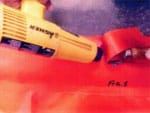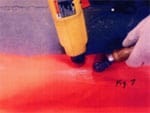ACME Fabric Repair Kit
ACME sells boom/fabric repair kits to help end-users repair containment boom that has been damaged. Containment boom can be damaged by rodent infestation and tears or abrasion during use or deployment. Boom should be clean and free of contaminants when stored. When storing boom for long periods of time, rat poison should be placed with the boom. ACME’s standard fabric/boom repair kit includes 6 square feet of fabric, 1 quart of adhesive, 1 roller, 1 brush and a carry case. ACME’s deluxe kit includes 6 square feet of fabric, 1 quart of adhesive, 1 roller, 1 brush, 1 hot air gun and a carry case. The deluxe kit provides the most durable repairs but the standard kit will work for small and standard tears. Instructions for repairing fabric using the deluxe kit can be found below.
Rips, tears and abrasions can affect any part of an oil spill containment boom (Figure 1).Tears can occur in the log pocket, skirt, chain pocket or top cable. The affected area that has been torn must first be cleaned with soap and water. Harsh chemicals and fuels should not be used to clean the boom. A mild detergent and medium bristled brush are ideal. Once the area has been dried then the repair process can begin. Cut a patch to cover the affected area. The patch needs to be of the same weight of fabric that was used in the original construction of the boom. The patch should be 3”-4” bigger than the affected area. Once the patch has been created, place it over the affected area and roll it back toward the roller (Figure 2). Make sure to use proper PPE during the repair in accordance with company safety policies and procedures. With the roller pressed against the patch, fold the patch material back over the roller and hold the patch and roller with one hand. Holding the patch and roller with one hand take the other hand, holding the heat gun and start applying heat to the area of where the patch is rolled onto affected area (Figures 3-5). Heat the patch and affected area until the fabric becomes “tacky” and slightly melted and roll the patch on to the affected area. After the patch has been heat sealed to the affected area the patch must be further heated and rolled onto the boom for contour and adhesive (Figure 6). Heating and rolling onto the patch ensures the patch is firmly secured to the boom fabric, making for an air tight and water tight seal (Figure 7).
ACME can make custom fabric repair kits that fit customer specific needs. Contact us today for a fabric repair kit quote!
Steps for repairing a fabric tear:
 A tear in the log pocket.
A tear in the log pocket.
 Placement of Fabric over the tear.
Placement of Fabric over the tear.
 Application of heat to area where patch will be applied.
Application of heat to area where patch will be applied.
 Rolling of patch onto affected area.
Rolling of patch onto affected area.
 Rolling of patch onto affected area.
Rolling of patch onto affected area.
 Patch application complete prior to final heating and rolling.
Patch application complete prior to final heating and rolling.
 Final heating and rolling.
Final heating and rolling.
For more information about ACME Fabric Repair Kits, view our links below:

